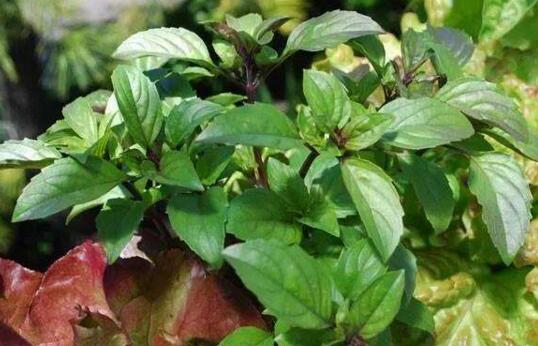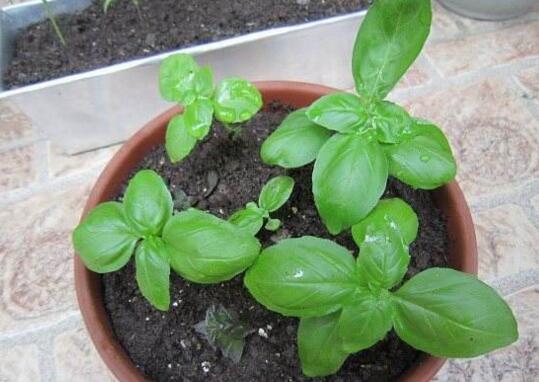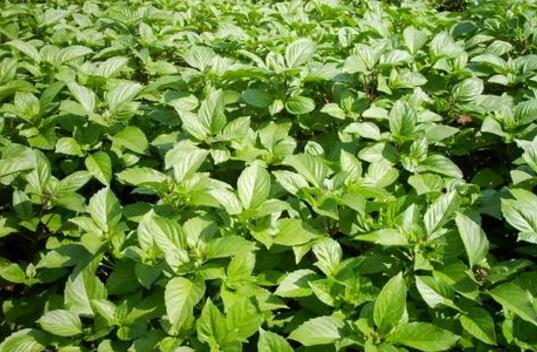Basil how to fertilize, four tips to make fertilization easier / stop fertilization in winter
Basil is a relatively strong plant, it has relatively low requirements for fertilizer, as long as it ensures that the soil is fertile enough, it can grow well, but in order to make the leaves greener, it can be fertilized reasonably in basil's breeding method. so how does basil fertilize? The editor will tell you the answer.
Does basil need fertilizer?

Under normal circumstances, basil does not need to be fertilized. If the selected soil is fertile and basic fertilizer is added when planting, then the nutrients needed for its growth are basically sufficient, but if the soil is barren, some fertilizer can be applied properly.
How long can basil be fertilized?
When basil grows 4-6 leaves, it can start to fertilize, fertilizer should be based on thin fertilizer and water, the purpose is to promote its root growth, only the root development is relatively rapid and perfect, its growth will be more exuberant.
How to fertilize basil
1. Fertilizer should be far away from the root.
Because basil is afraid of fertilizer damage, when applying fertilizer, fertilizer should be poured from the edge of the disk and keep the fertilizer away from the root as far as possible, otherwise it will easily lead to basil leaf hypertrophy and yellowing, which will affect its growth and beauty.
2. it is mainly based on thin fertilizer and water.
When basil grows to about 10 centimeters, you can apply some nitrogen fertilizer to it, preferably with thin water. If solid fertilizer is used, spread the fertilizer 4 centimeters above the root, and then water it properly, but do not have stagnant water.
3. No fertilization in rainy season and winter
How does basil fertilize during the usual rainy season and winter? The answer is to stop fertilization, especially in winter, because the growth of basil is very slow, fertilization not only can not promote growth, but will cause fertilizer damage.
4. Plants should not be contaminated with fertilizer.
When applying fertilizer, do not spray fertilizer and water directly on the leaves, the principle is the same as away from the roots, if the fertilizer comes into contact with the leaves, it is easy to cause the leaves to become fat and yellow, because basil mainly depends on the roots to absorb nutrients, not its leaves.
The method of raising basil indoors
Basil, also known as Lanxiang, Nine-story Pagoda or Shili incense, is one of the more common cooking herbs. In ancient Greece, basil was called the king of vanilla. Now there are many people like to plant basil at home, not only can play the effect of repelling mosquitoes, basil medicine can also promote blood circulation, drive the wind, has a certain medicinal value.
Basil
1. Basil breeding environment
It is understood that basil prefers a warm and humid environment, born in the subtropics, is not cold-resistant, drought-resistant, and is not strict with the soil. If you want to obtain high-yield and high-quality products, you should choose the soil with fertile soil and good drainage. Seedlings emerged in the south at the beginning of April and from the beginning of May to the middle of May in the north. The emergence time was related to the temperature at that time. If the temperature rose to 21: 25 ℃, the seedlings could emerge in 7-10 days. From the first ten days of May to the middle of June, the plant height increased the fastest and the number of leaves increased the most. The elongation of this period was mainly caused by the rapid elongation of many internodes, and the number of leaves no longer increased after flowering in the middle of June. the elongation in this period is caused by the elongation of the upper several internodes, so the plant height increases slowly.
Basil is strong in nature and easy to cultivate. because of its sexual preference for warmth, basil can grow well in all seasons. It grows slowly when the cold current hits in winter. It is cultivated in places with plenty of sunshine and good drainage. Although it will branch in clusters with its own growth after planting, if it can continue to pick and promote branches, the more branches and leaves can be harvested, and at the same time, restraining height can make it less easy to bloom. There is a folk saying that basil's flowers are poisonous. in fact, basil stems and leaves contain aroma, the texture of the inflorescence is thicker, it is not suitable for eating, and there is no toxic problem. Foreign countries harvest tender buds because they contain higher essential oil content.
It's easy to grow basil indoors. Container cultivation of basil should be planted in well-drained and nutritious soil. Using the appropriate soil type is important for the successful growth of basil inside. Basil is intolerant of water stress to ensure that the kettle provides adequate drainage. And the soil should be kept moist, it should not be dull; otherwise, the roots will rot easily.
Basil
Basil rooms are increasingly in need of fertilizer. Depending on the variety of growth and its general purpose, general indoor plant fertilizers can be used. Unlike many indoor plant fertilizers, this should be used in semi-recommended strength. However, basil is only used for seasoning food and requires the use of organic fertilizer. Organic fertilizers also help maintain pH when growing basil indoors.
Healthy pH value is another important aspect of quality soil. You should check that the pH value of the soil is about once a month or every 4 weeks for optimal growth. An adequate pH value is usually between 6.0 and 7.5.
Second, indoor lighting of basil
When planting basil indoors, lighting is very important. Basil rooms increasingly require at least 6 hours of sunlight. Basil's plants should be placed in a sunny window, preferably facing south. Otherwise, these potted plants may need to be planted under fluorescent lights. Using this type of lighting, basil plants will need about 10 hours of light to grow healthily. However, basil can also grow indoors by alternating so many hours in each given two suns and artificial lighting.
Basil is raised outdoors, but many people choose to raise it at home as greening and potted ornamental plants, and its tender stems and leaves can also be directly used for cooking and making soup, so it can be said that a small basil plays a great role.
Introduction to the cultivation methods of vanilla plants Fertilizer is like vitamins to plants. If you open a horticultural book and you can see all kinds of fertilizers, you may find gardening very difficult. However, it is not difficult to fertilize vanilla at all. Why? Because vanilla is a very tough plant, it doesn't need these artificial medicines very much. On the contrary, vanilla can fail because of too much fertilization. generally speaking, fertilization is the best when the season changes, but recently there is a so-called "vanilla fertilizer" on the market, which is even easier to use directly. If you are getting used to growing vanilla and want to formally breed vanilla, it is necessary to accumulate general knowledge about fertilization, or it is good to absorb it as a general basic knowledge of gardening. Key points for the cultivation of vanilla plants: first of all, it is not very difficult to cultivate vanilla only by remembering a few key points: first, there are many cultivated vanilla species that can be used as vanilla, but the most commonly used species are about 10 to 20, some of which are unacceptable to the Chinese, such as Dioscorea nigra, some are not suitable for the climate of Taiwan, such as Angelica sinensis, some of them are not strong aroma. There are many situations for cosmetology, such as aloe, so choosing the cultivated plant according to the purpose and mixing its characteristics is the first step of success. You can go to the flower market to buy the species you want to cultivate. After you buy it, use asexual cuttings or ramets to increase the number, or to buy seeds for cultivation. 2. Suitable cultivation environment this project includes the correct cultivation place or season. Before you buy vanilla and come back for cultivation, you need to know where you want to plant it and whether you have a garden at home. What are the sunshine conditions? Is the soil texture or drainage good or not? Do you want to plant it in a flowerpot or can you plant it directly on the ground? All these should be understood first, and then the species of vanilla to be cultivated should be selected by these conditions. even if they are not mixed with the characteristics of this species, you can ask the seller to help you choose or give you some advice. Some annual or biennial species will die after flowering, so they must carefully choose the right season to grow. Since most of these herbs are native to high latitudes, under Taiwan's climatic conditions, the cool winter climate is more favorable for growth. This is also the place to know first. Miniature potted flowers are available for home use and viewing. The front row is rosemary, the second row is two different varieties of lavender, and the back row is thyme, vanilla and lemon basil from left to right. Different kinds of vanilla should be planted in pots to match their growth characteristics. Vanilla on the left is suitable for shallow and wide pots, while rosemary on the right is suitable for larger pots. Third, careful and proper care of vanilla is a living plant, so it must be taken care of at all times in order to grow well. When taking care of it, it is necessary to observe the condition of the plant first. Take appropriate practices, such as watering until the soil is slightly dry before watering, so as not to suffocate the roots. Some species with thick leaves should not be watered too much. Moderate dryness is conducive to plant development and harvest. Or when pruning, do not cut too much at a time so as not to stimulate too big new buds to grow and die. During the period of rapid growth, some organic fertilizers are put on the soil surface, and when watering, the fertilizer seeps into the roots and absorbs it, which is conducive to good growth and development. As long as you pay attention to its growth at any time, everyone can try to plant it at home to increase the interest of life. Do not use pesticides in terms of pests, vanilla contains special odors, which are repellent to some pests, but some pests still eat leaves, such as basil. Some varieties of basil will have night thieves. At this time, you would rather spend a little effort to catch it by hand, or use an anti-insect net to cover and isolate it. Prevention is better than cure for diseases. The way is not to use cultivated old soil to grow vanilla, because hidden pathogens can become a source of infection. In addition, vanilla is cultivated in the right environment or season, so that the plant is strong and naturally resistant to disease. Remember that fresh vanilla is eaten raw or heated for a short time. If it contains pesticides, it will have adverse effects on your health. The above is the Zuihua Network on the maintenance of vanilla plants, I hope you can have some harvest!
- Prev

How to raise basil, basil breeding methods and precautions/temperature light is critical
Although basil leaves have many effects and functions, in order for these benefits to be fully exerted, it is necessary to ensure that basil grows healthily. Because basil is sensitive to temperature, it needs to master certain skills when breeding.
- Next

How to water basil, how often is basil watered / watering does not need too much / attached method
Through basil's breeding method, we know that it is a plant that likes a dry environment, and it is necessary to create such an environment as far as possible in the usual maintenance process. Watering has become a key link, which can neither be watered more nor be watered for a long time.
Related
- Fuxing push coffee new agricultural production and marketing class: lack of small-scale processing plants
- Jujube rice field leisure farm deep ploughing Yilan for five years to create a space for organic food and play
- Nongyu Farm-A trial of organic papaya for brave women with advanced technology
- Four points for attention in the prevention and control of diseases and insect pests of edible fungi
- How to add nutrient solution to Edible Fungi
- Is there any good way to control edible fungus mites?
- Open Inoculation Technology of Edible Fungi
- Is there any clever way to use fertilizer for edible fungus in winter?
- What agents are used to kill the pathogens of edible fungi in the mushroom shed?
- Rapid drying of Edible Fungi

